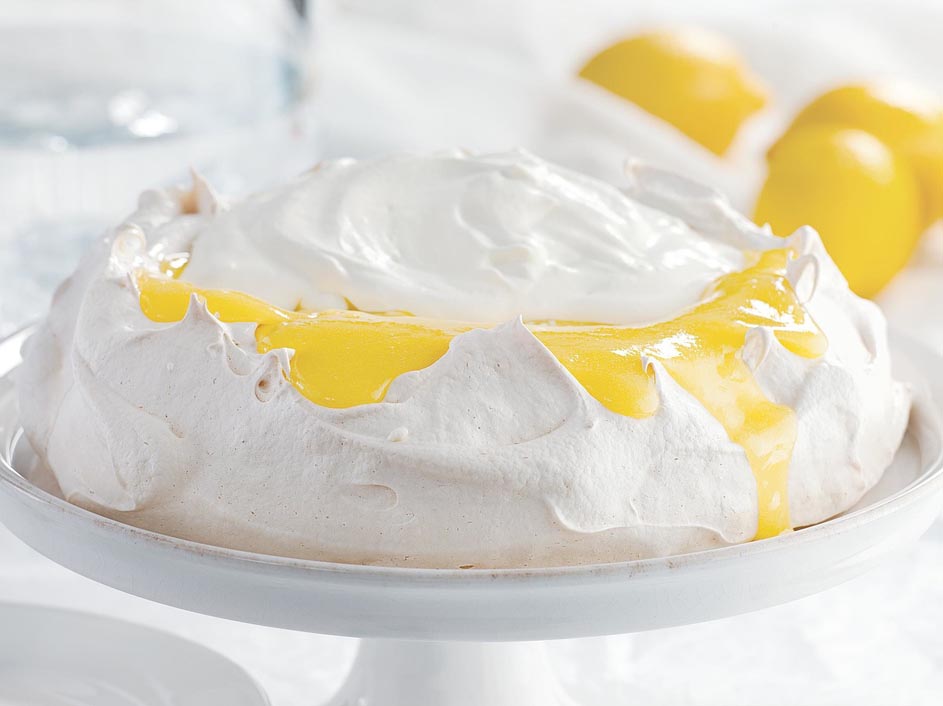Lemon Pavlova
8 servings
Active time: 45 minutes
Total time: 3 hours 45 minutes
Description
This show-stopping dessert is a New Zealand (and Australian) classic reportedly created in honor of the famous ballerina Anna Pavlova when she visited the Southern Hemisphere. Our version delivers a wonderful combination of sweet meringue crunch and velvety tart lemon curd. The meringue is somewhat fragile—expect it to crack and crumble a bit as you slice it into individual servings. For the best results, avoid making the meringue on a humid or rainy day. The extra moisture in the air may prevent it from drying and crisping properly.
Directions
- To prepare lemon curd: Whisk whole egg, 2 egg whites, granulated sugar, lemon zest and lemon juice in a medium nonreactive saucepan. Add butter and cook over low heat, whisking constantly, until the mixture is thick enough that drawing your finger across a coated spoon leaves a mark, 5 to 12 minutes. Do not let the sauce come to a simmer. Pour the hot curd through a fine-meshed sieve into a small bowl, pressing on the solids. Let cool slightly and refrigerate until chilled, about 4 hours.
- To prepare meringue: Preheat oven to 250°F. Line a large baking sheet with parchment paper. Draw a 9-inch circle with a pencil in the center of the paper to use as a guide for your pavlova, then turn the paper over so it’s pencil-side down.
- Beat 4 egg whites, cream of tartar and salt in a large bowl with an electric mixer on medium speed until soft peaks form. Increase the mixer speed to high and gradually beat in superfine sugar. Continue beating until stiff and glossy.
- Use the back of a spoon or a rubber spatula to spread the meringue into a 9-inch circle (using the guide) on the parchment. Smooth and level the center and make the edges slightly higher so there is a shallow depression in the middle. (It does not have to be completely smooth.) Bake the meringue for 1 hour.
- Reduce the oven temperature to 200° and continue baking for 1 hour more. The meringue should feel firm when gently touched.
- Turn off the oven, leave the door ajar and let the meringue sit in the oven until cool, about 1 hour. (As it cools, the exterior will crack in spots.)
- To prepare topping: Just before serving, whip cream in a small bowl with an electric mixer until starting to thicken. Add confectioners’ sugar and continue whipping until soft peaks form.
- To assemble pavlova: Use a large spatula or chef’s knife to carefully separate the meringue from the parchment and slide it onto a large flat serving platter. Fill the center depression with the lemon curd and pile the whipped cream in the center of the curd. Cut into wedges with a sharp knife. Serve immediately.
Tips
- Tip: When egg whites are beaten to “soft” peaks, the whites will still be soft enough to curl over when a beater is turned upside down. The whites are considered “stiff” peaks when they remain stiff and upright. To get the most volume from beaten eggs, it’s best for them to be at room temperature. Either set the eggs out on the counter for 15 minutes or submerge them in their shells in a bowl of lukewarm (not hot) water for 5 minutes.
- Tip: Be sure to use a nonreactive pan, baking dish or bowl—stainless-steel, enamel-coated or glass—when cooking with acidic food (citrus, cranberries, tomatoes) to prevent the food from reacting with the pan. Reactive pans, such as aluminum and cast-iron, can impart off colors and/or flavors.
- Tip: Superfine sugar dissolves instantly in liquid. To make your own, simply process regular granulated sugar in a food processor or clean coffee grinder until very fine.
- To make ahead: Cover and refrigerate the lemon curd for up to 1 week; bring to room temperature before assembling the pavlova. The cooled meringue can be stored in an airtight container in a cool, dry place (not the refrigerator) for up to 1 day.
© Meredith Operations Corporation. All rights reserved. Used with permission.
Nutrition Per Serving
- Calories256 cal
- Total Fat6.8 g
- Saturated Fat4 g
- Cholesterol0 mg
- Sodium74 mg
- Carbohydrate Total47 g
- Protein3.9 g
- Phosphorus27 mg
- Potassium102 mg
- Fiber0.1 g
- Calcium19 mg
Ingredients
Lemon Curd
- 1 large egg
- 2 large egg whites
- ¾ cup granulated sugar
- 1 tablespoon freshly grated lemon zest
- ⅔ cup lemon juice
- 1 tablespoon butter
Meringue
- 4 large egg whites, at room temperature
- ¼ teaspoon cream of tartar
- Pinch of salt
- 1 cup superfine sugar
Topping
- ½ cup whipping cream
- 2 teaspoons confectioners' sugar

